The alchemist
Bjarke Ingels, Architect
“The architect is more like a midwife, attending the permanent rebirth of a city.”
The office of the Bjarke Ingels Group is not located in the best part of Copenhagen. Indeed, Nørrebro is still considered a rough neighborhood even though its handful of hip cafes and galleries signal that gentrification is just around the corner. Founder and architect Bjarke Ingels, 38, has a surprisingly boyish demeanor. Full of enthusiasm, he shows us around the converted industrial property. In the middle an open cafeteria boasts a table-tennis table as a place to meet and eat. Around it are long tables where some 80 employees work on international projects. Bjarke Ingels has just returned from Miami, having previously visited his new office in New York. Although he soon will depart again to Asia, he shows hardly any traces of fatigue. On the tour of the office he points out models, plans, pictures. The first examples of his “pragmatic-utopian architecture” can already be inspected – after the many competitions he has won in recent years, new, increasingly large-scale projects will soon join them. His work is characterized by his view of buildings not as solitary objects, but functionally integrated into the urban environment in which they are built – and which he wants to help shape in his own way. Celebrated as one of the most innovative architects of his generation, in his projects, lectures, articles and books Bjarke Ingels continues to challenge his profession by questioning architecture’s traditional approaches.
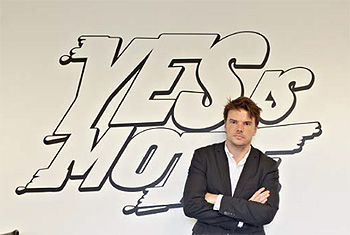
The Focus: You recently published “Yes is More,” a monograph in the form of a comic about your office, BIG (Bjarke Ingels Group). Was this a conscious break from the norm?
Bjarke Ingels: The title “Yes is More” is a take on Mies van der Rohe’s “Less is More.” He triggered the modernist revolution, so this might sound rebellious. On the contrary – with “Yes is More” we are basically trying to question the idea that the architectural avant-garde is almost always defined negatively, in terms of who or what we are against. There is a cliché of the radical architect as an angry young man rebelling against the establishment. Or as a misunderstood genius, frustrated that the world doesn’t fit in with his or her ideas. In fact we are much more interested in evolution than revolution – the idea that things gradually evolve by improvising and adapting to the changes of the world. Plus I have to admit that drawing a comic strip was my childhood dream.
The Focus: How did you end up in architecture then?
Ingels: I think it was the result of immaturity, actually. I graduated from high school and I didn’t have a plan for what came next – apart from knowing that I wanted to create graphic novels. I have been drawing all my life; it was the one thing that I was really good at. But when I graduated, there was no clear path that would take me there, especially not in Denmark. I considered the different careers available to people who could draw and thought about becoming an art director in an advertising agency. It wasn’t what I really wanted, but at least I might have a chance to apply my skills in the way I wanted. However, my dad was very skeptical. He was worried about me not having an academic degree, so he suggested I try architecture. In Denmark you train to be an architect in an art academy, and the program is very non-structured.
The Focus: How did you find your own style?
Ingels: I came to architecture without any prior knowledge. When I started I was familiar with Jan Utzon, the Danish architect who designed the Sydney Opera House. Apart from him I couldn’t name a single architect. That also meant that I didn’t have any kind of preconceived notions, not even a basis for forming opinions about architecture. Since there wasn’t much structure I actually just went to the library and got excited by various architects. A large part of my studies consisted of finding an article about something that really interested me and then looking up the footnotes. In this way, I built up a little collection of ideas and gradually could start forming my own.
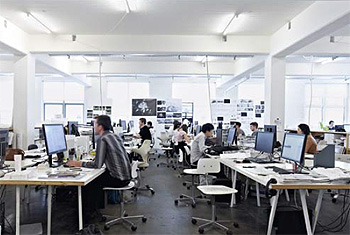
The Focus: How did you implement your first ideas?
Ingels: I went to work at OMA for Rem Koolhaas, and I soon figured out that hardly anybody in the office knew what was going on. Everybody was just trying to make something that Rem would pick. This was when I realized that production is more important than reflection. If there is nothing to reflect upon, if nobody has done anything yet, you are just sitting there with a white page and there is nothing to discuss. As soon as you accumulate material, you can start discussing and suddenly ideas will pop up. That will lead to more production, which can in turn lead to more reflection.
It also prevents a monopoly on creativity. No one has to wait for the boss to say, “Do this.” Everybody at Rem Koolhaas’ office is free to make proposals. What guides the creative process is the selection, not the initiative. Rather than having a top-down bottleneck, where only a single individual, the creative genius, comes up with brilliant ideas and then the subordinates have to deliver, it is actually possible to do things the other way around. Everybody has a license to create. Through a much more informed process – a parametric process of editing and selecting, adding and suggesting – we can evolve an idea.
The Focus: Do you still prefer a challenging environment like this?
Ingels: Yes. To achieve this, my principle for collaboration is to make things external. That is why we print things and build physical models all the time, because anything you have inside your head is inaccessible to the rest of the group. Just verbalizing your idea can lead to endless arguments, because people see what you are saying differently. In that sense, any idea, any observation, any piece of analysis has be given physical form – get mounted on the walls, put into a PDF or built into a model. Through this process of constant materialization and reiteration, the project crystallizes. Different ideas can be materialized in different forms. Sometimes it is a quick collage. Sometimes it is a piece of statistic. Sometimes it is even a statement or diagram that will manifest the idea and make it available to the collective process.
The Focus: One thing that seems to make you different from other architects is that you are hard to typecast – you are neither a starchitect nor a traditional designer.
Ingels: I think that architecture has been suffering from this dichotomy. You either have corporate consultants that do reliable but predictable and boring architecture, or you have the avant-garde, which has been dominated by often unreasonable artists who create things that look different and therefore might add value in terms of recognizability and spectacular global attention. But they are quite often impractical, overpriced, and don’t perform as well as the run-of-the-mill buildings.
The Focus: How do you overcome the dichotomy of the genius versus the engineer?
Ingels: We try to commit ourselves to some form of innovative sobriety. Our buildings end up looking different because they perform differently. We are doing a project in Vancouver which is in a very difficult site located between the supports of a grand old bridge. We have designed a building that expands to double size at the top and develops a really elegant silhouette. As you come into downtown Vancouver it will be like an amazing gesture. So it will become a landmark and have a unique appearance compared to all other towers – not least in Vancouver. But what makes it look spectacular and expressive is actually what makes it perform better in terms of real estate, because it increases the client’s floor area ratio by 50 percent. Not only that, but if you take an 85-square-meter apartment, and you move it one floor up in Vancouver, you get between $15,000 and $20,000 more value. So taking the same apartment and moving it 20 floors up gives you $400,000. We end up giving him a 50-percent increase in the most valuable real estate. In that sense the client’s criteria – he is a developer – are profit-driven; it’s all about efficiency, floor area ratio, a suitable location. As many people would complain, this normally leads to cookie-cutter boxes. In this case, applying performance criteria actually leads to something that is out of the ordinary. The uniqueness and the performance become one and the same.
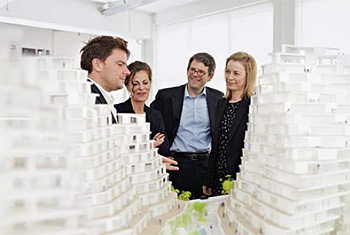
The Focus: More and more architects subscribe to design thinking, the approach of solving very basic social, urban or financial problems with their planning. What set of problems do you think architecture can best address?
Ingels: When it comes to building in urban environments, the main role of the architect is to facilitate the cohabitation of a great number of people of various nationalities, cultural and religious backgrounds, ages, incomes, even food preferences. The main principle to follow is that everyone has the right to be there.
The Focus: Is it difficult to implement ideas like this?
Ingels: First we might have to change the approach taken by architecture. What limits architecture is that it is so expensive, and therefore clients are risk-averse. The investments are written off over quite a long period, so you want to look 50 or 100 years into the future. Take the project we are building in Manhattan. It may not the biggest building in Manhattan, but it costs twice as much as Avatar, the most expensive movie ever made. A film like Avatar has to perform well for three months and then the investment is returned – or not. This building needs to perform over decades, and if there is any kind of problem or technical issue you will also pay the price over decades. Therefore, even though innovation is what really drives us, we always try to find examples where what we are proposing has already been done – because clients aren’t willing to try things unless they have already proven successful. I think where you can really make a difference is by constantly trying new things, even minor innovations. This creates a precedence, moves the innovation towards the safe side. Gradually you can change how things are done. I think that if you try to test a single new idea in each project, and you implement it successfully, it can have a sort of ripple effect throughout the global architecture scene. By being copied or appropriated by others, you can actually contribute.
The Focus: What could be the innovative aspect of a building like this?
Ingels: The Mountain and the 8 House, buildings we did in Copenhagen, just happened to look like mountains. But they actually look different because they perform differently. They harvest resources – daylight or views for example – in different ways. We try to maximize possibilities. With those buildings and with our project in Manhattan we try to take some of the suburban advantages, like a house with a yard where your kids can go outside and play, and combine them with the services of a dense urban space. But this also changes the impact of a building. Normally urban development happens at the expense of nature. In our case the buildings are actually creating nature. They not only look like mountains, they also operate like mountains. They accumulate solar energy and water. They create an ecosystem.
The Focus: That sounds a lot like an urban version of geoengineering, while at the same time altering urban society.
Ingels: Architecture is not an isolated art that doesn’t affect the rest of the world. It is the physical manifestation of all forces that shape a society. There is constant development and change. The architect is more like a midwife for the permanent rebirth of a city and less like her creator. Our role is to help society express itself.
The Focus: Is that still architecture, or are we moving towards sociology?
Ingels: A lot of what happens in architecture used to come from society itself. When I teach at Harvard or Yale or at Columbia, I always use the time to do some research as well. Recently I looked into what you would call vernacular architecture, a term traditionally used to identify architecture that has been designed without architects. For example, the white, flat-roofed villages of Greece look very different from Swiss villages with their sloping roofs, large overhangs and shutters, because they are in different climates. Over time the local population has found out that by having the white-painted houses with the flat roofs, you reflect as much heat as possible and can actually access the roof and the cool wind at night. In Switzerland the sloping roofs had to do with using the snow for insulation.
The Focus: Do you use these findings in your projects?
Ingels: Yes, you get a lot of architectural styles that have nothing to do with academia or aesthetics but are purely empirical discoveries. The buildings look the way they do to increase the occupants’ quality of life. In a way we are trying to return to this. The international style of modernism coupled with the advent of building engineering and building services meant that you could replace daylight with electric light, insulation and solar orientation with air conditioning and central heating, and open windows with mechanical ventilation. In the end, the building didn’t do anything anymore. The architecture of the building was just a boring box, with a lot of big machinery in the basement consuming a lot of energy. The machines were essentially a mechanical compensation for the fact that the building was bad at what it was designed for. When we apply the principle of once again trying to make buildings suitable for different climates, a building in Dubai will look different from a building in Iceland.
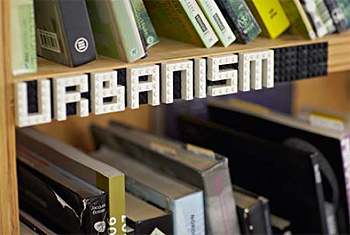
The Focus: How far do you compromise on projects?
Ingels: At the end of the day, it is the client’s building. If you cannot persuade them to do things your way, then either the client is stubborn or there is typically a good reason for their refusal. Of course we don’t agree on everything, but we try to get optimal results and keep in mind that it is not going to be our building, but theirs. Of course we like to see our creative ideas take shape, but it is always about the project and achieving the greatest potential.
The Focus: Is there any kind of project where you would say, “No, I won’t do it”?
Ingels: We were doing a project in Korea for one of those enormous conglomerates which are hard to define because they have so many different subsidiaries. We did the design, they really liked it, and then they said that they had changed the use of the project – it was going to be utilized for military purposes. That was a no-go for us.
The Focus: You seem very interested in science fiction. Is there a particular reason behind this interest?
Ingels: My fascination with the genre has a lot to do with science fiction being the literary pursuit of an idea, or the consequences of an idea. The narrative basically unfolds by exploring the consequences, the potential and the problems of this idea, this innovation. Essentially that is what our design process is like. We come up with an idea that is derived from an analysis that shows potential, and then the design process is about trying to achieve the potential and solve the problems that cascade as a result of the initial innovation.
The Focus: Is that a new approach to the creative process in architecture?
Ingels: I think it would be for a lot of architects. The biggest difference in our case is something else, though. In a global context, we often get complimented for actually being able to explain what we are doing. A lot of other architects have a hard time talking about their work. It is very important to understand that this has nothing to do with having a better communications department. We simply talk about what we have done. We spend a lot of effort on constantly clarifying the issues. This becomes a very powerful tool in the design process, and perhaps allows us to arrive at certain ideas that other people might not be able to reach. We somehow have a stronger process for creating the clarity that is necessary to see what you are doing.
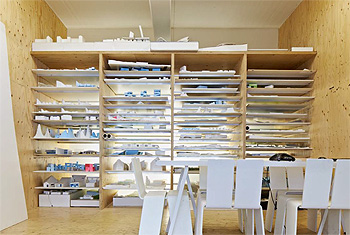
The Focus: How did you communicate the idea of bringing the Little Mermaid to the Danish pavilion at the Shanghai Expo?
Ingels: I had to speak in Parliament. Architects don’t have political power, and we don’t have financial power, but we do have the power of our ideas. We made a strong and persuasive case about the pavilion and about authenticity. China is often associated with copyright issues. So in the Chinese context the Little Mermaid would stand out as something that was purely poetic and original. Plus more Chinese than Danes have read Hans Christian Andersen, because it is actually part of the Chinese public school curriculum. It represents the strongest common denominator between Denmark and China. Andersen’s stories The Little Mermaid, The Little Match Girl, and The Emperor’s New Clothes are essentially parts of Danish culture that have been adopted into Chinese culture. The whole idea was to give the 1.3 billion Chinese people who grew up with the Little Mermaid a unique opportunity to experience her in real life. It made so much sense. Only the Danish Nationalist Party tried to pass a law against moving the Mermaid. So I had to appear before Parliament to argue my point.
The Focus: Was the Mermaid part of the original concept?
Ingels: That idea evolved out of the design process. Before Shanghai we went on a field trip to the 2008 World Expo in Zaragoza to research how to design national pavilions – or not to. We spent a day walking around the different pavilions to see how others before us had approached the same task. We found that World Expos seem to be orgies of state-financed propaganda, full of pretty pictures and catchy statements but void of real experiences. Drawn by the queue in front of the German pavilion, we found that it was the result of bad logistics rather than attractive content. A “boat ride” on a flooded conveyor belt took visitors past various Tony Stone stock images of smiling corporate executives and cute kids or random installations of water fixtures like a wall of bathroom sinks installed to celebrate the Expo’s water theme – a stale hybrid between a tradeshow and a sustainability advertising campaign. After a full day of “sightseeing” the only taste of reality had been the port wine in the Portuguese café. We thought, what if we could turn the Danish pavilion into an experience of real life in a Danish city. Not just a story about it – or an image of it – but the real deal?
The Focus: Architects like Peter Eisenman study philosophical texts before they start a project. How often do you delve into subjects outside of architecture and design?
Ingels: You don’t have to look to French philosophy or the Kabala to make architecture interesting. The right mix of practical and everyday ingredients such as inexpensive apartments, the desire for a house with a garden, the need to resolve parking and the optimal orientation for daylight and views can turn in to a potent mixture of architectural alchemy.
The Focus: You have talked about this concept of architectural alchemy before – could you expand on it for us?
Ingels: Rather than choosing between the practical and the ideal, we strive towards a pragmatic utopian architecture that turns making the world a better place into a practical objective. Alchemy was originally about trying to blend different metals or chemical compounds to create gold. Architectural alchemy mixes a variety of functions that have different parameters and different success criteria. Traditionally you would put them in different buildings or even in different neighborhoods. You’d put all the residences in the suburb, all the offices in the office park, and all the retail outlets in the shopping mall. But as a negative side effect, you have no synergies. Architectural alchemy is an architectural appropriation of Adam Smith’s invisible hand. If each element is allowed to gravitate towards its favorite position in the block, the shop moves towards where the customers are, offices turn to the north where you get daylight but no glare or overheating, and houses go towards views and sunshine. As an architect you can try to facilitate this process – as if guided by an invisible hand, each element actually gets to fulfill its greatest wish. You can create, if not gold, then at least added value.
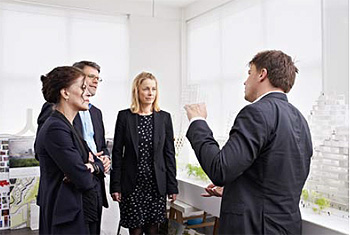
Talking with Bjarke Ingels in Copenhagen: Ulrike Mertens, Jörg Thierfelder and Inge Berneke (from left) from Egon Zehnder.
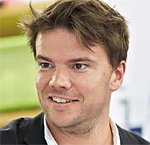
Bjarke Ingels
Born in Copenhagen, Denmark in 1974, Bjarke Ingels is an architect and founder of the Bjarke Ingels Group, also known as BIG. After completing his education at the Danish Academy of Art, he got his start working for Rem Koolhaas in his Office for Metropolitan Architecture. Ingels next joined forces with Belgian architect Julien De Smedt to open their own architectural office, PLOT. In 2004 the two men were honored with the Golden Lion at the International Architecture Exhibition in Venice for their design for a concert hall in Stavanger, Norway. Ingels founded BIG in 2006 and soon built his reputation by winning a substantial number of competitions. His projects, such as The Mountain residential complex in Copenhagen and the Danish Maritime Museum in Helsingør, are pioneering examples of his “pragmatic-utopian architecture.” Ingels gained international renown as the architect of the Danish pavilion at the 2011 Expo in Shanghai. He succeeded in having Denmark’s national treasure, the Little Mermaid statue, shipped from the Copenhagen harbor to China for the event. In recent years he has worked on large-scale projects in New York, Mexico, Azerbaijan and China.





